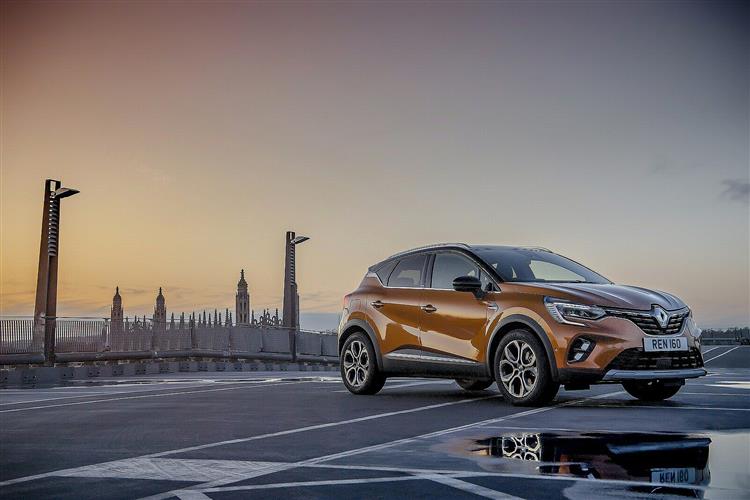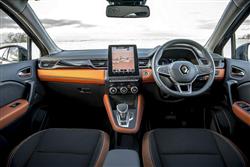How will you view?
This is a sample, showing 30 seconds of each section.
CAPTURING A VERY SMALL MARKET (some text hidden) SECTIONED_new_renaultcapturetechpluginhybrid160_2021
By Jonathan Crouch
Introductionword count: 105
Renault has been a market leader in delivering Plug-in hybrid technology in smaller cars - models like this one, the Captur E-TECH Plug-in Hybrid 160, which sold between 2020 and 2023. This compact crossover offered a 31 mile electric driving range and super-low Benefit-in-Kind taxation exposure, both things common in this class and highly valued by potential customers. Here though, it was all presented with a combination of family friendly flexibility - the sliding rear bench for instance - and a bit of Gallic pizzaz courtesy of the available opportunities for bodywork and cabin customisation. Which all created a car that's worth a second look.
Modelsword count: 4
5dr SUV (1.6 PHEV)
Historyword count: 216
By 2020, slowly but surely, Plug-in Hybrid technology was beginning to get more affordable amongst family cars - and the list of choices available was gradually widening. If you want this kind of tech when the time next comes to swap your used family car, then here's one of the most affordable ways to get it - Renault's Captur E-TECH Plug-in Hybrid 160, the PHEV version of our market's favourite Renault model. There were actually two Captur E-TECH hybrid models. The other was a more affordable variant you couldn't plug in, the E-TECH Hybrid 140, which used the same powertrain fitted to petrol/electric versions of the Clio supermini and might actually be a better bet for quite a few customers perusing what's on offer here. Our focus in this review though, is on the Plug-in Captur 160 model, which thanks to its much larger 9.8kWh battery could offer the commuting distance all-electric driving range that its self-charging E-TECH showroom stablemate lacked. And, thanks to that, the kind of super-low CO2 reading that in turn, delivered a super-low Benefit-in-Kind tax liability. There was quite a steep price tag though, to go with this kind of capability - which meant that numbers sold were few and Renault withdrew the PHEV Captur from sale at the end of 2023.
What You Getword count: 470
PHEV models are usually difficult to differentiate from their more conventional counterparts and this Captur E-TECH Plug-in Hybrid is no exception. The differences in chassis structure are slight too - the second generation Captur model line's CMF-B ('Common Module Family, B'-segment) platform was designed from the outset to support Hybrid and plug-in electrification - though, curiously, not a full-EV model. In this period, Renault covered off the battery-only part of the small hatch market with its little ZOE hatch, but that car couldn't offer the streetside presence or personalisation options on offer here. In profile, you get a feel for that. The roof, for instance, could from new be specified in contrasting colours - grey, white, orange or 'Diamond Black'. The side sills could be finished in orange or grey. And trendy big wheels could also feature - up to 18-inches in size, though the 'S-Edition' variant settled for 17-inch 'Bahamas' diamond cut rims. At the wheel, there's an EV Button amongst the piano-style keys below a central 9.3-inch portrait-style 'EasyLink' infotainment screen which has various EV-specific menus, including a useful 'Energy Info' graphic showing at any given time what's being powered by what. The 10-inch instrument binnacle display is EV-specific too, most of the E-TECH features showcased in the right hand virtual dial. As well as a lower charge meter, this features an outer rim showing blue 'regenerative', green 'charge' and white 'power' zones. And has a central area showing a triangulation of battery, e-motor and engine to depict in real time the hyperactive hybrid system's flow of energy. Glance down at the 'e-shifter' auto gearstick and you might notice its extra regenerative braking 'B' option, this lever sitting on top of the unusual 'floating'-style centre console fitted to all automatic Captur models, with a cool blue light shining beneath this protrusion onto the wireless 'phone charger beneath. Otherwise, things are just as they would be in any other well specified Captur - and further brightened in some cases by the optional 'Signature orange interior colour pack' which added a bit of colour to the cabin. In the rear, it actually feels very decently spacious by class standards, helped by the fact that this second generation Captur's CMF-B platform allowed for a 17mm rear legroom increase. Despite the fact that the PHEV system's battery was placed under this rear bench, it still kept the sliding function you'll find in more conventional Captur variants, moving back and forth over a range of 160mm. A rival Kia Niro plug-in model from this period can't be had with a sliding rear seat, while with a rival MINI Countryman PHEV, this feature cost extra. Out back, this Captur gets the usual 60:40-split affair which, when pushed forward, frees up 1,118-litres of capacity (down from 1,275-litres normally) across an almost-flat load floor of 1.57m.
To see the full road test text contact us on 0330 0020 227
Pictures (high res disabled)

.jpg)
|
.jpg)
|
.jpg)
| |||
.jpg)
|
.jpg)
|
.jpg)
| |||
.jpg)
|
.jpg)
|

|
Scoring (subset of scores)
Category: Hybrid, Plug-in, Electric & Hydrogen
| Performance | |
| Handling | |
| Comfort | |
| Space | |
| Styling, Build, Value, Equipment, Depreciation, Handling, Insurance and Total scores are available with our full data feed. | |



